The availability of pharmacies serves a vital role in the United States healthcare system, especially for individuals seeking essential prescription drugs. However, there have been emerging concerns surrounding pharmacy shortages in recent years.
With the nation’s largest drugstore chains facing mounting pressure, the increase in drug scarcity has created challenges for patients looking to secure their prescriptions locally and conveniently.
To reveal the effects of national drug shortages on accessing prescription drugs, we take a closer look at the US states facing the biggest challenges, from the number of pharmacists per population to notable drug store closures.
States with the biggest pharmacy shortages
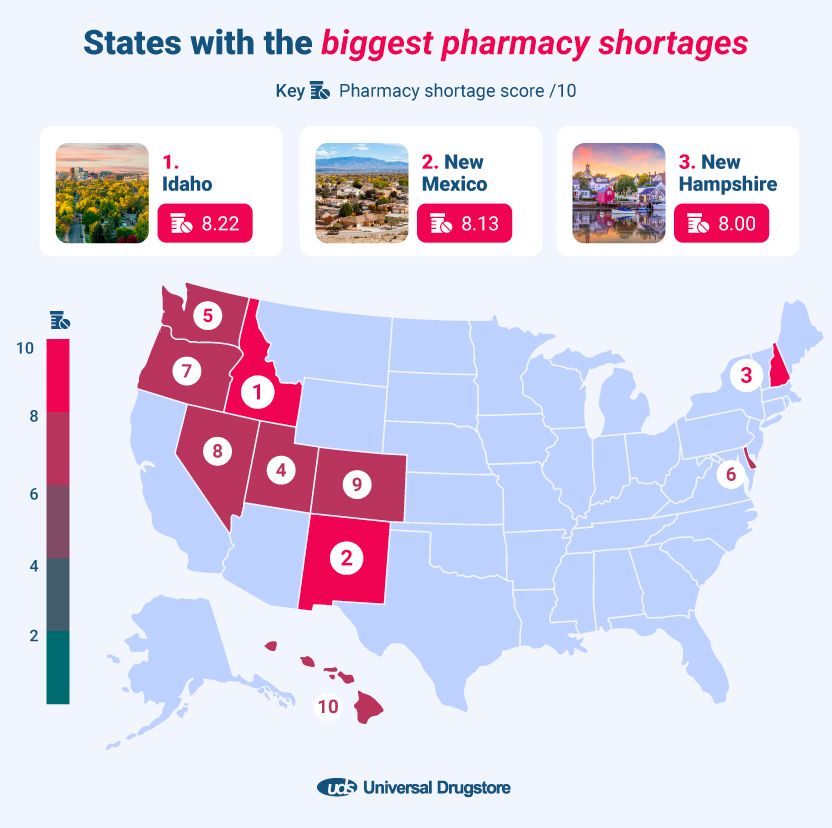

- Idaho
Pharmacy shortage score: 8.22/10
Idaho is the state with the biggest pharmacy shortage in the country, scoring 8.22 out of 10. Not only did the landlocked state see a 5.31% decline in pharmacy jobs from 2021 to 2022, but it also fell short regarding the number of major drug stores, having only 2 CVS stores per one million population, the lowest among any other US state.
-
New Mexico
Pharmacy shortage score: 8.13/10With a score of 8.13 out of 10, New Mexico has the second-highest pharmacy shortage in the United States. On average, there are just 11 CVS drugstores per one million population, meaning residents may find it less convenient to access their prescriptions. Moreover, the Southwestern state saw a massive -8.56% decline in pharmacy jobs by 2022, making it one of the top five states to do so.
- New Hampshire
Pharmacy shortage score: 8/10
New Hampshire completes the top three with a pharmacy shortage score of 8 out of 10. Not only did the Northeastern state see a -1.76 % decrease in pharmacy jobs between 2021 and 2022, but it also needs to catch up when it comes to aiding pharmacy students as it is one of only two states with no accredited pharmacy schools.
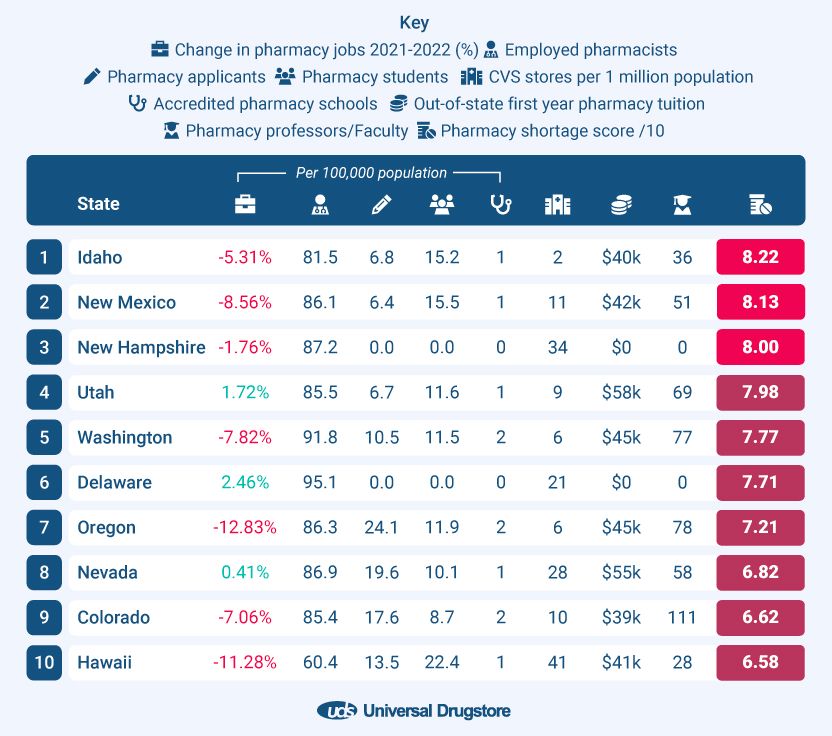

States with the most drugstore closures
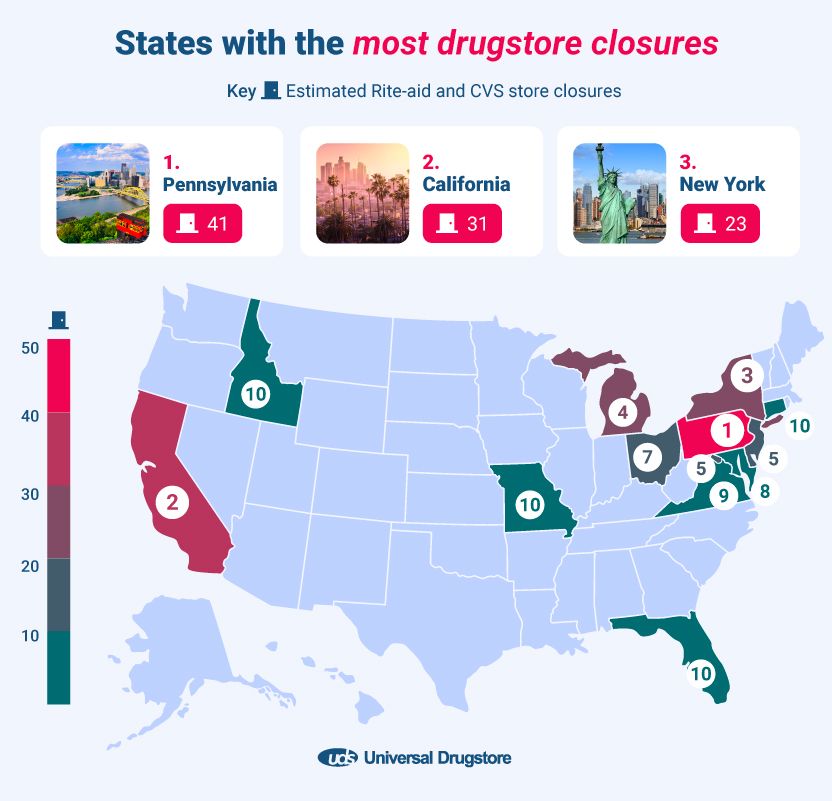

-
Pennsylvania
Estimated Rite-aid and CVS store closures: 41Despite over 9,000 CVS stores and more than 1,700 Rite-aid stores in the US, nearly 1,5001 drugstores, including Walgreens, are being shut down. Pennsylvania is the most targeted location for closures, with 41 Rite-aid stores already in the pipeline.
-
California
Estimated Rite-aid and CVS store closures: 31California follows closely behind with 31 Rite-aid stores set to close. The major pharmacy chain, which operates in 17 US states, is said to be filing for bankruptcy and thus will potentially close more retail locations in the coming months. Hence, it comes as little surprise that California is one of the first states to get hit with so many closures as it has the most Rite-aid stores in the country (384 stores).
-
New York
Estimated Rite-aid and CVS store closures: 23With 20 Rite-aid stores and three CVS being axed, New York completes the top three states with the most drug store closures. More than 500 CVS stores and over 200 Rite-aid stores are currently operating in the Big Apple. However, with the rate of stores closing down, residents may start to experience delays in their prescriptions.
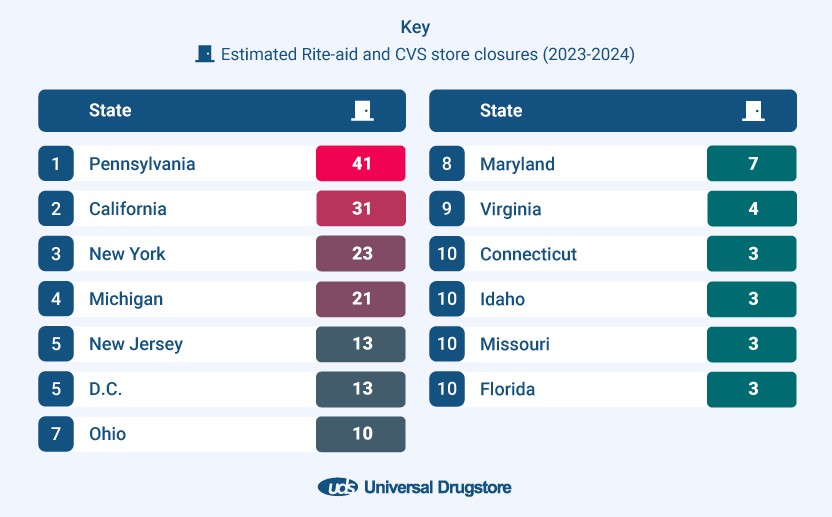

States with the fewest CVS drug stores
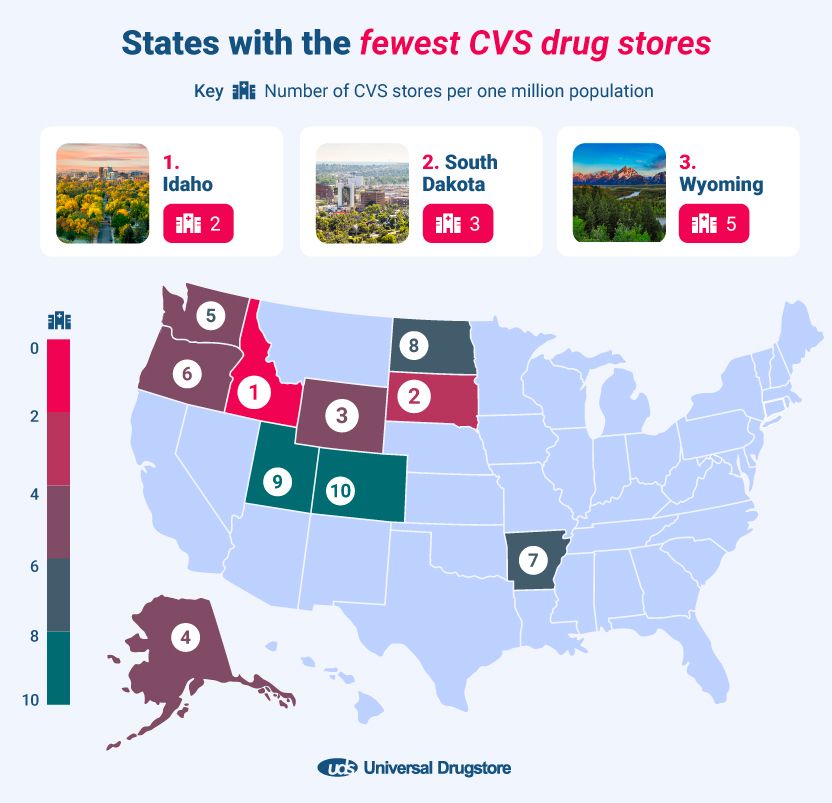

-
Idaho
Number of CVS stores per one million population: 2With just two stores per one million population, Idaho has the fewest CVS stores in the United States, making access to prescription drugs more challenging for residents. Despite being the nation’s largest pharmacy chain, CVS, much like other major drug stores in the US, now has longer wait times due to a decline in staff.
-
South Dakota
Number of CVS stores per one million population: 3Following closely behind is South Dakota with an estimated three CVS stores per one million population. The scarcity of pharmacists and technicians threatens patients’ access to healthcare and has led to pharmacies scaling back their hours statewide. Not only is the state experiencing the consequences of short-staffed pharmacies, but research suggests that the South Dakota State University pharmacy enrollment has also decreased by over a third (34%).
-
Wyoming
Number of CVS stores per one million population: 5Wyoming has approximately five CVS stores per one million population. Like in other states, Wyoming has seen CVS eliminating some store locations due to a decline in profit in recent years. This results from lower reimbursement rates for prescription drugs despite most sales being from filling prescriptions.
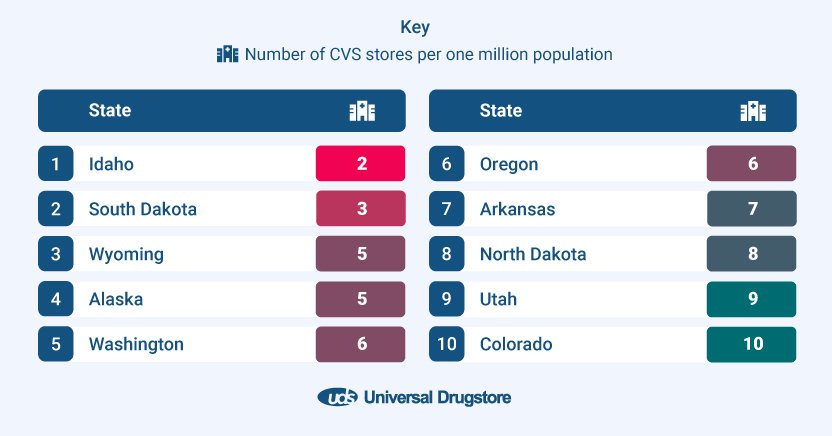

States with the highest decline in pharmacy jobs
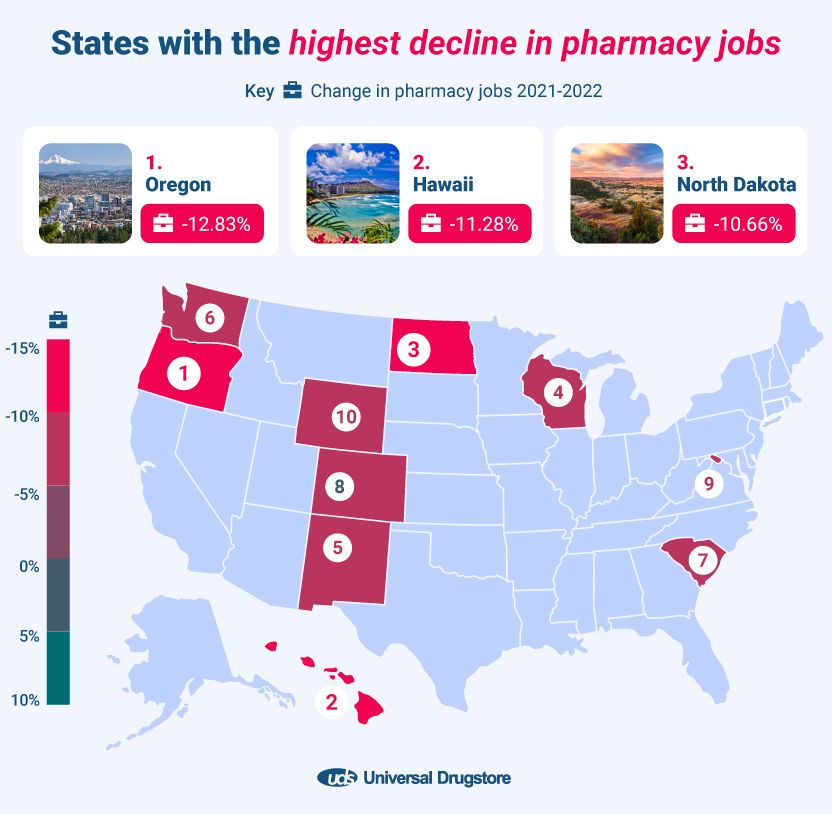

-
Oregon
Change in pharmacy jobs 2021-2022: -12.83%Oregon has the highest decline in pharmacy jobs, with a decrease of 12.83% in just one year. The northwestern state has experienced drugstore closures and staffing shortages, making pharmacies less accessible to many residents, resulting in patients waiting in long lines and difficulty contacting overworked pharmacy staff.
-
Hawaii
Change in pharmacy jobs 2021-2022: -11.28%Having seen a decline in pharmacy jobs, going from 1.649 in 2021 to 1.463 the following year, Hawaii follows behind in second place with a decrease of 11.28%. As a result, drugstores within the state have been experiencing various challenges, from pharmacist shortages to heavy workloads.
-
North Dakota
Change in pharmacy jobs 2021-2022: -10.66%Pharmacy jobs in North Dakota have seen a steady decline in employment rate over the past year, with a decrease of over 10%. Interestingly, North Dakota is the only state that promotes independent pharmacies as it requires only licensed pharmacists or groups of pharmacists to own and operate a pharmacy.
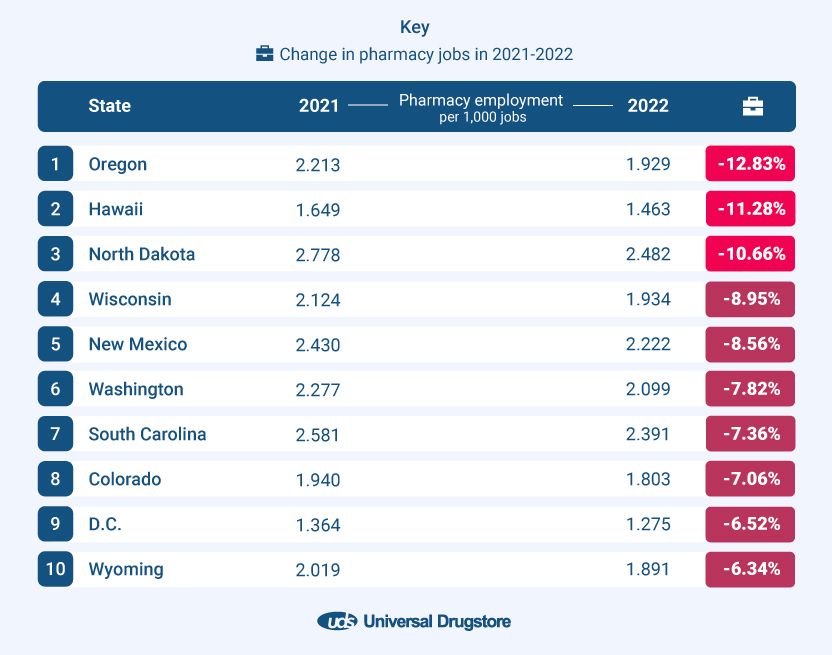

States with the least pharmacists
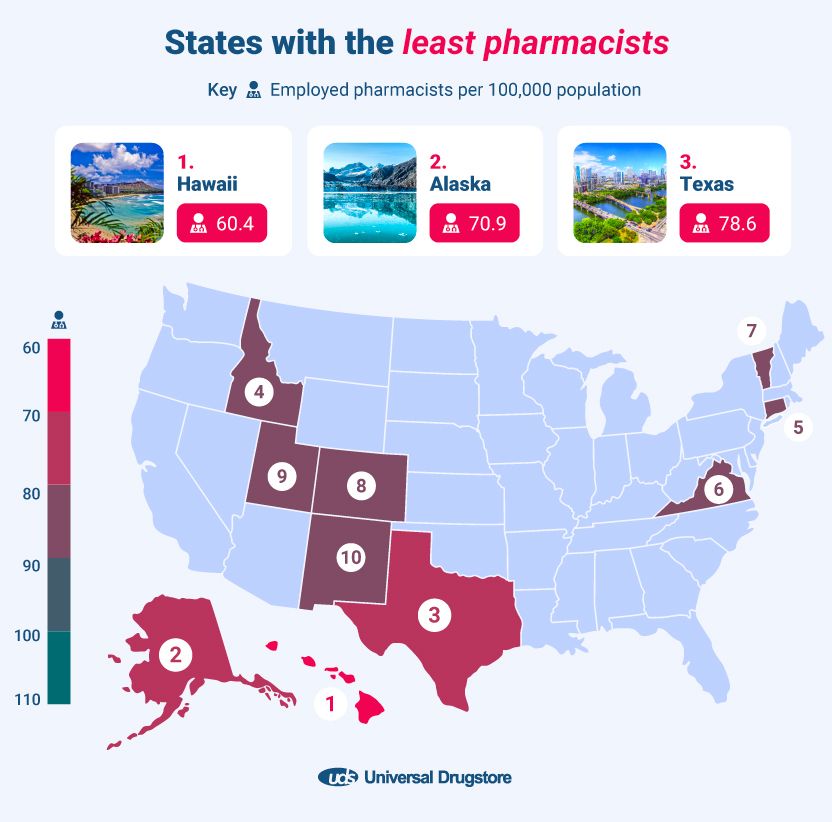

-
Hawaii
Employed pharmacists per 100,000 population: 60.4Hawaii has the lowest number of pharmacists, with a rate of 60.4 per 100,000 population. According to the Hawaii State Legislature, the state faces a significant shortage of healthcare professionals, especially in rural areas. Due to this, several healthcare community stakeholders are trying to retain and recruit qualified providers in the state.
-
Alaska
Employed pharmacists per 100,000 population: 70.9In second place is Alaska, with an estimated average of 70.9 employed pharmacists per 100,000 population. The northwest state has experienced an ongoing shortage of pharmacists over the years due to increased workload and difficult working conditions, leading to more pharmacists retiring or leaving the field early. This means pharmacies are open for fewer hours and have longer prescription waiting times.
-
Texas
Employed pharmacists per 100,000 population: 78.6With approximately 78.6 employed pharmacists per 100,000 population in 2022, Texas ranks third with the fewest pharmacists. The Lone Star State has experienced a significant lack of staffing among major drugstores such as CVS and Walgreens, making pharmacists' jobs more difficult.
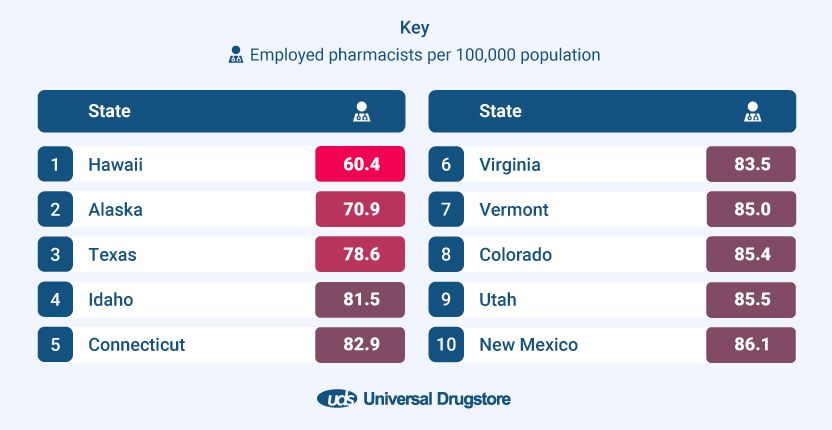

States with the least pharmacy schools
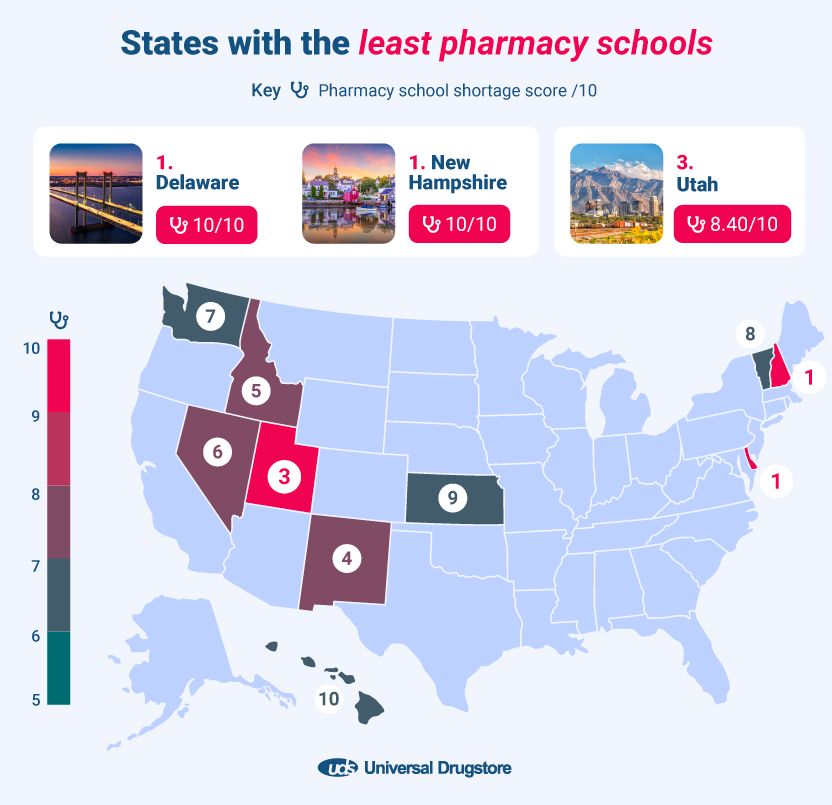

-
Delaware & New Hampshire
Pharmacy school shortage score: 10/10Delaware and New Hampshire top the list in joint first place with no physical accredited pharmacy schools. This means that students in these states looking to study pharmacy will have to go out-of-state for their studies, which might mean higher tuition fees overall.
-
Utah
Pharmacy school shortage score: 8.40/10Utah completes the top three, scoring 8.40 out of 10. Despite only one accredited pharmacy school in the state, it has the highest out-of-state tuition fee of any other state, costing first-year students a whopping $58,384. Utah is one of the top ten US states with the fewest pharmacy school applicants and enrolled pharmacy students per 100,000 population.
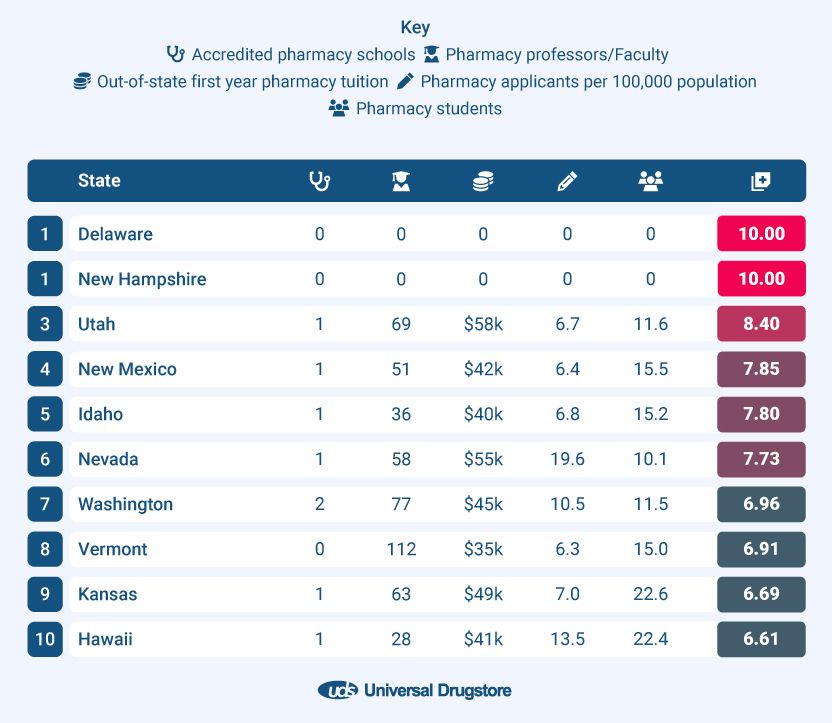

The national decline in pharmacy degrees
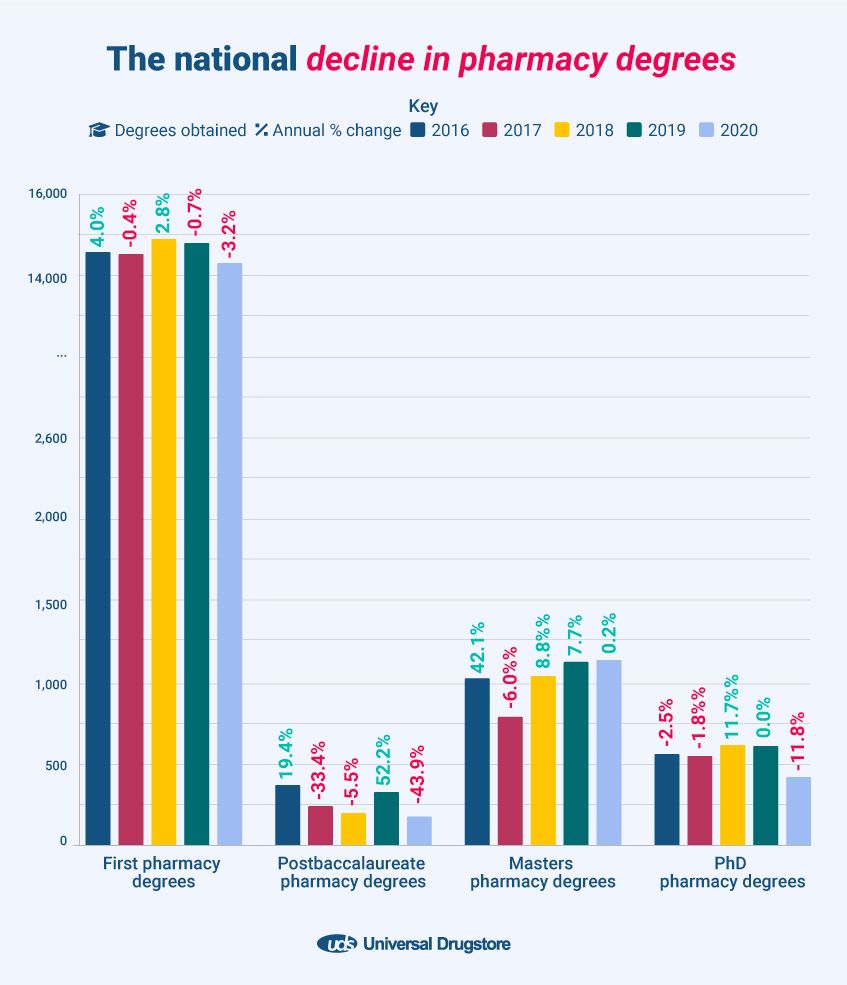

Between 2016 and 2020, there was a nationwide decline in the number of pharmacy degrees obtained in the United States. Between 2019 and 2020, there was a 3.2% decrease in graduates with their first pharmacy degree. The year before that (2018), it was a 0.7% decline.
Despite an increase of over half (52%) in 2019, by 2020, the number of postbaccalaureate pharmacy degrees went down by a staggering over two-fifths (43.9%), the lowest it has ever been in five years.
Masters degrees saw a slight increase of 0.2% in the number of degrees received, while PhD pharmacy degrees went down by 11.8%.
National decline in pharmacy degrees by gender
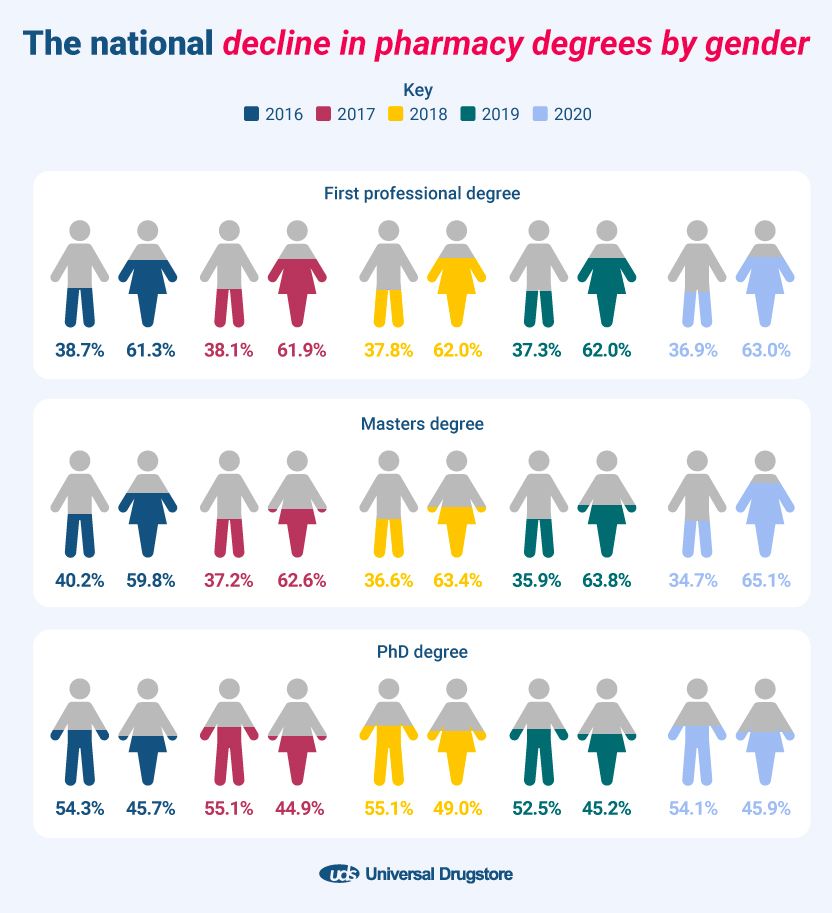

Regarding gender, more women obtained their first degree in pharmacy than men throughout the years. Interestingly, men have experienced a steady decline in pharmacy degrees received since 2016, while women have gradually increased.
By 2020, almost two-thirds (63%) of women graduated with a first professional degree in pharmacy compared to just over a third of men (36.9%).
Although 65% of women received a master's degree compared to over a third (34.7%) of men, men (54.1%) are more likely to graduate with a PhD in pharmacy than women (45.9%).
The current severity of drug shortages
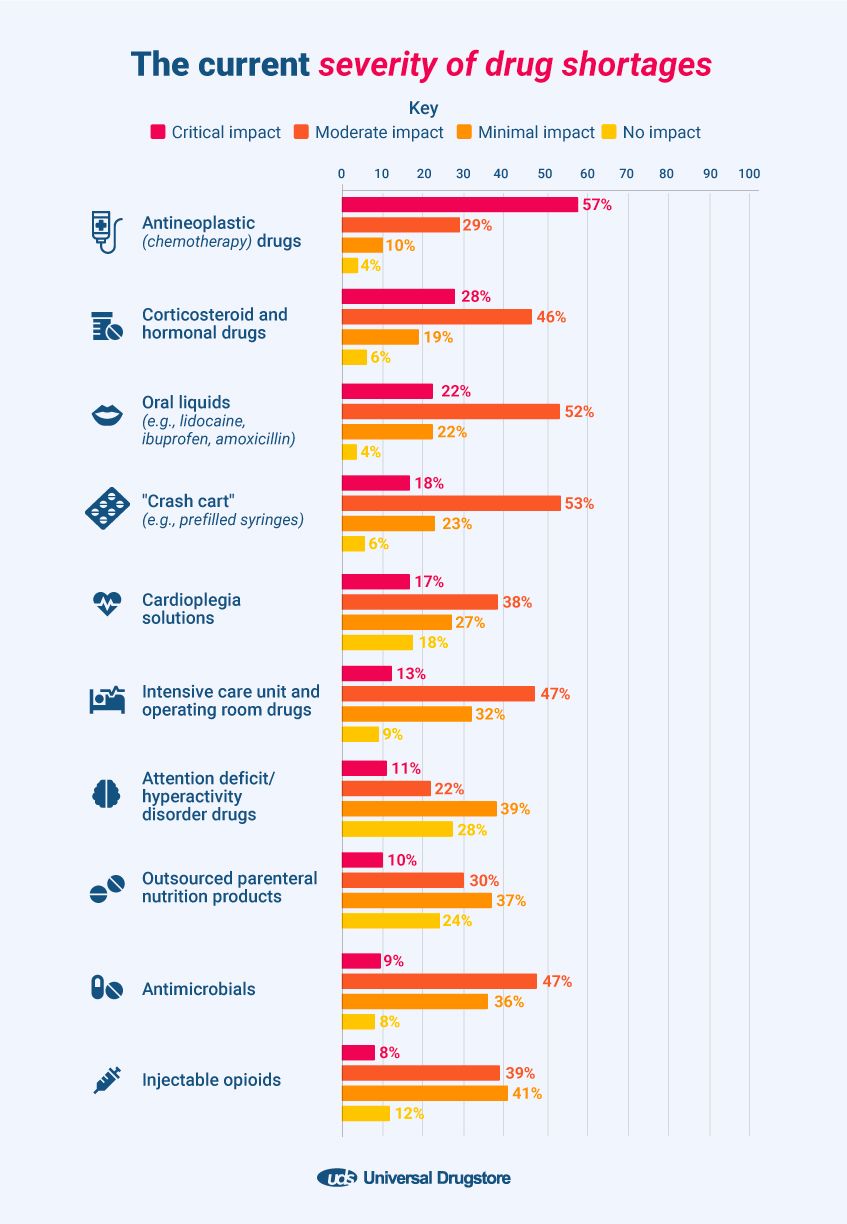

In a recent survey report conducted by the American Society of HealthSystem Pharmacists9 (ASHP), participants were asked to rank the current severity of drug shortages ranging from critical impact (rationing, canceling, or delaying treatment and procedures) to no impact (managing shortages with no effect on patient care).
Almost two-thirds (62%) of respondents indicated that their organization is currently experiencing a moderate level of drug shortages, while 32% said that they are in a critical state. Only 4% of respondents characterized shortages as having a minimal impact, whereas only three percent admitted to experiencing no scarcity.
Over half (57%) of respondents highlighted that the shortages of antineoplastic drugs, primarily used for chemotherapy, have had a critical impact on how they treat patients.
Just over half of the responses stated that the scarcity of ‘crash cart’ emergency drugs (53%), such as prefilled syringes and oral liquids (52%), including lidocaine, ibuprofen, and amoxicillin, have had a moderate impact on their ability to treat patients adequately.
Methodology
We used the U.S. Bureau of Labor Statistics to gather data on the year-on-year percentage difference in pharmacy jobs from 2021 to 2022. We then ranked these figures to find the states with the highest decline in pharmacy jobs.
Using the US Census, we collected the number of employed pharmacists in each state in 2022 using the same source. This was calculated per 100,000 population using the 2022 estimated figures for consistency. This data was collected on 02/08/2024.
We used the Pharmacy School Finder to determine the states with the least enrolled pharmacy students. This considered the following factors by state: number of accredited pharmacy schools, pharmacy applicants, pharmacy professors/faculty, out-of-state tuition for the first year, and the number of enrolled pharmacy students. This data was collected on 02/14/2024.
Using 2023 population figures, the number of pharmacy applicants and enrolled students was calculated per 100,000 population to normalize the data.
On 02/15/2014, we gathered data for the general national pharmacy statistics. We used PubMed Central to collect data on the yearly percentage decline in pharmacy degrees in the United States from 2015 to 2020. This was also done by gender split and level of degree. For this, we specifically used tables 5 and 6.
The CVS Store Locator was used to gather the estimated total number of drugstores per state on 02/13/2024. This was then calculated per 100,000 population (2023) and ranked to find the states with the least CVS stores.
To determine the states with the most drugstore closures in 2023, we used articles including AI.com and Florida Today. We then totaled these figures up by state and ranked them in order. Please note that we only used the list of store closures available during data collection. Data collection for this section was completed on 02/14/2024.
Drug shortage statistics were taken from the ASHP report for June/July 2023 on 02/14/2024. We specifically looked at the ‘severity of shortages’ (p.2) and ‘the cost of shortages’ (p.4) sections.
To calculate a normalized pharmacy shortage score out of 10 for each state, we considered the following factors:
The decline in pharmacy jobs by state 2021-2022 (%), the rate of employed pharmacists per 100,000 population, the number of CVS stores per 100,000 population, the number of accredited pharmacy schools by state, the number of enrolled pharmacy students per 100,000 population, the estimated number of pharmacy school applicants per 100,000 population, the out-of-state first-year tuition First Year and the number of pharmacy professors/faculty.
Each factor was individually given a normalized score out of 10 before the overall score out of 10 was determined. Data collection for this section was completed on 02/15/2024.
To find the states with the biggest pharmacy schooling shortages, we gave each state a normalized score out of 10 before the overall score out of 10 was determined. We included the factors: the number of accredited pharmacy schools by state, the number of enrolled pharmacy students per 100,000 population, the estimated number of pharmacy school applicants per 100,000 population, the out-of-state first-year tuition First Year, and the number of pharmacy professors/faculty.
References:
- https://www.forbes.com/sites/pamdanziger/2023/09/27/drugstore-downsizing-cvs-walgreens-and-rite-aid-to-close-nearly-1500-stores/?sh=276688f6e560
- https://southdakotasearchlight.com/2023/01/21/pharmacy-shortage-south-dakota-threatens-access-to-health-care/
- https://www.oregonlive.com/data/2022/01/closures-staffing-shortages-make-pharmacies-less-accessible-for-many-oregonians-heres-what-the-data-says.html
- https://www.hawaiitribune-herald.com/2023/10/08/nation-world-news/pharmacist-shortages-and-heavy-workloads-challenge-drugstores-heading-into-their-busy-season/
- https://www.wbur.org/onpoint/2023/12/04/the-looming-pharmacy-crisis-in-america
- https://www.capitol.hawaii.gov/sessions/session2023/Testimony/SCR17_SD1_TESTIMONY_CPC-LMG_04-13-23_.PDF
- https://www.ktoo.org/2023/10/03/alaska-pharmacist-shortage/
- https://www.texasstandard.org/stories/grassroots-pharmacist-walk-outs-spread-in-response-to-complaints-over-working-conditions/
- https://www.ashp.org/-/media/assets/drug-shortages/docs/ASHP-2023-Drug-Shortages-Survey-Report.pdf
- https://wieck-vizient-production.s3.us-west-1.amazonaws.com/page-Brum/attachment/c9dba646f40b9b5def8032480ea51e1e85194129
About Universal Drugstore
Universal Drugstore is a licensed online pharmacy and one of Canada's oldest, largest, and most trusted online prescription referral services, with over 22 years of experience assisting individuals in accessing affordable prescription drugs, OTC drugs, and pet meds. Universal Drugstore offers significant discounts and savings for medications and pet meds needs, with prices up to 80% lower than a local or online pharmacy.








